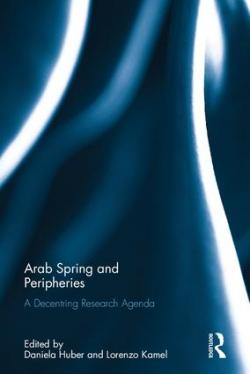Arab Spring and Peripheries. A Decentring Research Agenda

The emerging literature on the so-called ‘Arab Spring’ has largely focused on the evolution of the uprisings in cities and power centres. In order to reach a more diversified and inner understanding of the ‘Arab Spring’, this edited book examines how peripheries have reacted and contributed to the historical dynamics at work in the Middle East and North Africa. It rejects the idea that the ‘Arab Spring’ is a unitary process and shows that it consists of diverse Springs which differed in terms of opportunity structure, strategies of a variance of actors, and outcomes. This book looks at geographical, religious, gender and ethnical peripheries, conceptualizing periphery as a dynamic structure which can expand and contract. It shows that the seeds for changing the face of politics and polities are within peripheries themselves. Focusing on the voices of peripheries can therefore be a powerful tool to ‘de-simplify’ the reading of the Arab Spring and to reshape the paradigmatic schemes through which to look at this part of the world.
Precedentemente pubblicato come numero speciale di Mediterranean Politics, Vol. 20, No. 2 (July 2015).
Citation Information
Notes on Contributors
1. Arab Spring: The Role of the Peripheries, by Lorenzo Kamel and Daniela Huber
2. Transition and Marginalization: Locating Spaces for Discursive Contestation in Post-Revolution Tunisia, by Edwige A. Fortier
3. The Peripheries of Gender and Sexuality in the ‘Arab Spring’, by Maryam Khalid
4. Secular Autocracy vs. Sectarian Democracy? Weighing Reasons for Christian Support for Regime Transition in Syria and Egypt, by Mark Farha and Salma Mousa
5. Plus ça change? Observing the Dynamics of Morocco’s ‘Arab Spring’ in the High Atlas, by Sylvia I. Bergh and Daniele Rossi-Doria
6. Territorial Stress in Morocco: From Democratic to Autonomist Demands in Popular Protests in the Rif, by Ángela Suárez Collado
7. Protests Under Occupation: The Spring inside Western Sahara, by Irene Fernández-Molina
8. Periphery Discourse: An Alternative Media Eye on the Geographical, Social and Media Peripheries in Egypt’s Spring, by Khaled Elghamry
9. Arab Spring: A Decentring Research Agenda, by Lorenzo Kamel and Daniela Huber
Index
Tema
Tag
Contenuti collegati
-
Pubblicazione01/07/2015
Arab Spring: A Decentring Research Agenda
leggi tutto -
Pubblicazione07/02/2015
Arab Spring: The Role of the Peripheries
leggi tutto



